About Competition | Blogging | Example Application | The Prizes | The Kit | The Judges | Terms & Conditions | The Challengers | The Winners
Vibrations exist all around us. Pendulums, springs, tubes, and in the electronics world, an inductor connected across a capacitor carrying a charge all are examples of objects that vibrate. Caused by forces acting on an object, vibrations are small displacements from an object's equilibrium or resting position. But they also set up a restoring force to get it back to a state of equilibrium. Think of Newton's First Law of Motion. Why are vibrations important? They give us information about the state of a system. But what can we do to harness the information that vibrations provide us? Studying or experimenting with vibration sensors is a good place to start. This was the premise behind element14 offering an "Experimenting with Vibration Sensors" Design Challenge.
In this challenge, element14 provided the challengers with an vibration sensor kit consisting of a KEMET's VS vibration sensorKEMET's VS vibration sensor, the ST Microelectronics's NUCLEO-H743ZINUCLEO-H743ZI STM32 Nucleo-144 board & the X-NUCLEO-IDB05A1 X-NUCLEO-IDB05A1 Bluetooth Low Energy expansion board. They were challenged to conduct experiments using the vibration sensor provided in the kit, and write at least two blogs on their experiments. We had 14 challengers complete the competition. There was a wide range of experiments, exhibiting technical skill, cleverness and creativity. There were some surprising vibration sensor experiments, spanning things like musical instruments, automotive disc brakes, machine safety, the Stirling engine, electric motors, footstep vibrations, air conditioner compressors, sleep seizure detection, and exercise machines. All of them shared their experiments and learning experiences on vibration sensors for the entire element14 community to enjoy. ( We also asked the baldengineer to experiment with the KEMET vibration sensor kit. Check out his blog to read about his experience and watch his videos: TOKIN Vibration Sensor Hands-On | element14 | Experimenting with Vibration Sensors )
 Experimenting is a lot of hard work! That's why we decided to offer some really great prizes for the best writeups for the experiments. The grand prize is Microsoft Surface Pro X + accessories, and the runner up prize is an Apple Series 5 Watch. All finishers (must have completed 2 blogs) will receive a Google Nest Hub Smart Display with Google Assistant. The competition period is now complete, and the entries are in. Our judges read all of the challengers' blogs and chose the winners.
Experimenting is a lot of hard work! That's why we decided to offer some really great prizes for the best writeups for the experiments. The grand prize is Microsoft Surface Pro X + accessories, and the runner up prize is an Apple Series 5 Watch. All finishers (must have completed 2 blogs) will receive a Google Nest Hub Smart Display with Google Assistant. The competition period is now complete, and the entries are in. Our judges read all of the challengers' blogs and chose the winners.
Without further adieu, here are the winners of the element14 Experimenting with Vibration Sensors Challenge, sponsored by KEMET:
The Grand Prize: dougw
 dougw | Stirling Engine and Vibration Sensor
dougw | Stirling Engine and Vibration Sensor
dougw performed several experiments. He also designed a number of parts and produced numerous videos which explain in detail all of his experiments. His first experiments characterized the KEMET sensor to better understand its performance. His main experiment involved using the vibration sensor with a Stirling engineer. The engine was highly unbalanced and it vibrated so violently that its whole chassis moves around on the table, even with rubber feet. He wanted to try different techniques to minimize vibration and stop it from wandering around. He used the Kemet vibration sensor to quantify vibration with each mounting method and each balancing method to see which ones were practical and which ones do the best job of reducing unwanted motion. He didn't just want to minimize vibration of the engine, he also wanted to minimize vibration of the table, hence, he used the vibration sensor on both the engine and the table. I found his videos highly instructive.
The Runner Up Prize: neuromodulator
neuromodulator | Motor Vibrations Experiments
neuromodulator used the vibration sensor to perform vibration analysis of a motor. Rotating machinery produces vibrations that depend on their structural properties. One important component of rotating machinery are the bearings. Ball bearings produce a vibration signature that depends on bearing properties (i.e., number of balls, diameter of the balls, the inner and the outer race, etc.). By analyzing the vibration signature it is possible to identify what exactly is damaged, and how damaged it is. To perform these analysis the time series have to be converted from time domain to angular domain (this conversion process is called order tracking). The spectrum in the in the angular domain then indicates the kind of damage (seen as a frequency component) and the amount of damage (seen as the amplitude of the peak). His plan was to build a system to perform vibration analyses in real-time. His testing system consisted of a motor, the sensor attached to the motor, a way to measure the rotational speed, a data acquisition system and a computer that will run the software that will perform the analyses.
The Honorable Mentions: yosoufe and zst123
We had not initially planned on offering Honorable Mentions. But both our judges felt these two challengers posted really good experiments and deserved mentioning. (I'm trying to find a special prize for our Honorable Mention winners.)
yosoufe | Vibration Sensors and Exercising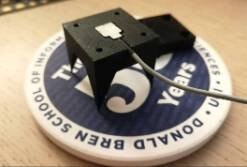
yosoufe wanted to experiment with exercise equipment vibrations. He describes his challenge in this way: "During the COVID-19 time my wife and I are exercising inside our apartment. The building is made of a wooden structure and sometimes it vibrates a lot. The main goal is to study the vibrations caused by our exercise. We try our best not to bother the neighbors but I think the noise of our exercising can be annoying to the people who are living in the apartment below our apartment." He tried to measure the vibration during exercise and find a threshold that should not be exceeded. In the event the vibration exceeds the threshold, a notification system would tell we are too noisy. Both I and the judges felt yosoufe made a great attempt at explaining what he did in his experiments, which really helped make his entry standout.
zst123 | Patterns produced by different vibrating devices
zst123 conducted experiments to observe patterns produced by different vibrating devices(i.e., computer fan or hard disks) using the KEMET vibration sensor attached to it. To start, he conducted a preliminary experiment to compare the threshold needed to detect vibrations. He demonstrated how to use an ADC on a microcontroller to visualize sensor's vibration sensitivity on a PC. For example, he differentiated between hard and soft taps on the device. After completing his preliminary experiment he turned his attention to characterizing the RPM of a spinning device by looking at the FFT dominant frequency. This is done by applying the FFT algorithm using data from the STM32. He wrote seven blogs. I think he did a good job of walking us through his process, coding examples, and experiments. He performed 4 experiments: 1 – Initial Setup & Tapping Experiment; 2 – Detect Spinning Fan Obstructions; 3 – Fourier Transform Analysis to find RPM; and 4 – FFT Dashboard with Mbed DSP.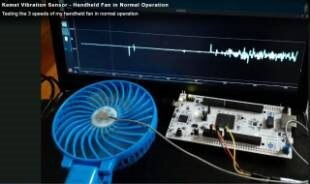
The Finisher Prizes
Experimenting with Vibration Sensors is a continuation of a "different" kind of design competition offered by the element14 Community. It gave the challengers an opportunity to experiment, test, breadboard, or just play around with vibration sensors. We received 44 applications, and we sent inductors kits to 14 applicants. In no special order, here are the challengers who finished the challenge and will receive a finisher's prize.
ashok r | Vibration Sensors and Musical Instruments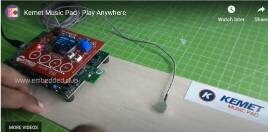
ashok r conducted experiments to understand sensor behavior. He connected the output pin of a USB analyzer and measured the frequency. He also conducted an experiment to generate music through vibration. Using software and FFT analyses, he designed an instrument called the "KEMET Music Pad" (also called the Music Surface Kit). When you clap your hands you can hear a sound, which is turned into music based on the variation, vibration and velocity.
 charlieo21 | Automotive Vibration Sensor Application
charlieo21 | Automotive Vibration Sensor Application
charlieo21 conducted an experiment to measure the vibration that is present in the boards of a vehicle, specifically, in a vehicle that is designed and assembled in my work on an autonomous electric vehicle in an elevated railway. He also measured the vibration in different locations of my car to see the difference in two different transit systems.
dwinhold | Machinery Safety Experiments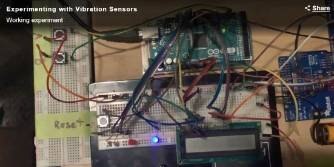
dwinhold said in his blogs that he works with different machines that require the perfect balancing of knives and blades. If the machine knives or blades become unbalanced, damage can occur to the machine, or worse, injure the operator. This can be avoided with an automatic shut off system. He experimented with a vibration sensor used in this safety system. The sensor would record when the machine becomes unbalanced and shut it down. He first conducted some benchmarking experiment with the KEMET vibration sensor. Then he experimented with setting the machines slightly unbalanced (in a controlled, safe environment) and get a benchmark for when to shut the machine down. While doing this, I will safely show the power and speed of these machines when something goes wrong.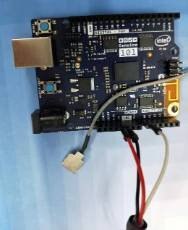
fyaocn | Vibration Tracing on A Car
fyaocn planned to build a portable tool for vibration tracing on car to show different modes of the car, such as braking, bumping, etc., and then recording the data from Kemet vibration sensor. He would build a CNN model and train with DL framework. He would deploy the model on the Embedded platform to be used as predictive maintenance hub. His final blog was comprised of three mini-experiments: GUI tools touchGFX or some lightvgl, one new Deep Learning framework, and one new Development Board from ST, STM32H747-DISCO, to deploy with embedded xcube-AI or some new board like STM32G431-nucleo.
guillengap | Investigating & identifying threshold sound or vibration levels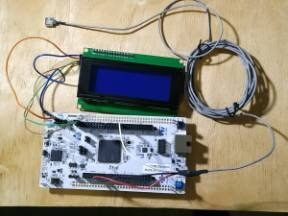
guillengap explains in his first blog that there are some concerns about ground-borne perceptible vibrations and both ground-borne and airborne sound transmission from nearby rail and vehicle traffic can pose a potential risk to the well being of many different aquatic species housed in the aquaculture tanks; in particular, acoustically sensitive sharks, turtles and "bony fish." To address this problem, he planned on investigating and identifying the threshold sound or vibration levels that might adversely affect these aquatic species in terms of their health, behavior and reproductive capabilities.
jissdeodates | Noise & vibration analysis of automotive disc brakes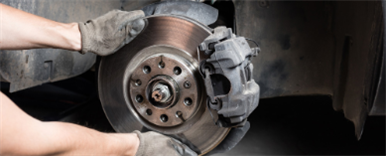
jissdeodates explains that brake noise and vibration control are important for the improvement of vehicle quietness and passenger comfort. In addition, proper noise and vibration analysis of a vehicle's disc brakes can help in the early maintenance and safety of the vehicle. The vibration and noise raised by automobile braking have been one of the most difficult concerns since their inception, especially due to the fact that root causes are very difficult to discover. The vibration's nature is not repeatable due to the different parameters: pressure, velocity, temperature. These parameters create difficult conditions to investigate the phenomena. jissdeodates experimented with KEMET's VS vibration sensor, NUCLEO-H743ZI microcontroller, and the X-NUCLEO-IDB05A1X-NUCLEO-IDB05A1 Bluetooth Expansion Board to explore the problem of braking vibrations.
ralphjy | Footstep Vibration Sensing
ralphjy conducted experiments to determine who was present in a room using the vibration pattern from their footsteps. He was inspired to do this type of experimentation from an article in Scientific American about using footstep sensors to identify people by their gait. He reports that "much of the work that I've seen in human presence detection using footsteps or gait has used other types of sensors (pressure or audio). I thought that it would be an interesting experiment to see if it would work with the Kemet vibration sensor."
swathic | Machinery Vibrations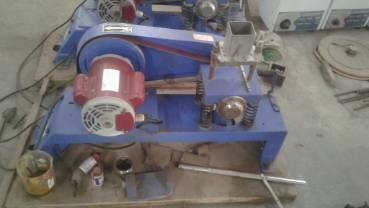
swathic discusses that machinery are common in every place from house to industrial applications for construction and utilization for our daily needs. These machinery have parts like motors, valves, gears, belts, etc. and to understand their operation sensors are placed to identify their current conditions. In order to caliber the system health one of the important sensors is the vibration sensor with that the condition monitoring data can be used for analysis like predictive maintenance or vibration analysis in order to study the health of the machinery. swathic conducted experiments with the KEMET Vibration Sensor VS-BV203-B to measure the machinery parts in the frequency range of 10 Hz up to 15 kHz. This range is enough to figure out the vibrations of parts. It can be interfaced to the NUCLEO-H743ZI board GPIO pins to read the data and transfer to the remote device via X-NUCLEO-IDB05A1X-NUCLEO-IDB05A1 Bluetooth Low Energy evaluation board.
 souravv | Monitor Vibrations in an Air Conditioner Compressor
souravv | Monitor Vibrations in an Air Conditioner Compressor
souravv reports that vibration sensors have extensive applications in predictive maintenance and have been used in the industry for long enough now. He planned on conducting experiment to measure the natural vibration in an internal combustion (IC) engine to calculate the precise acceleration and other IMU readings. The need for this project arose from an industry project I was working On in which we had to control a driverless IC engine based car based on IMU readings. The second experiment he wanted to conduct concerns the predictive scheduling of maintenance tasks for household appliances.
gam3t3ch | Sleep seizure detection system and more
gam3t3ch experimented with a system to detect the uncommon movements in sleep with a vibration sensor. These types of movements can be indicative of a person who may be experiencing a seizure. It should be noted that seizures will not be tested in these experiments; rather, he focused on the most common data from visual muscle twitches and jerks, with possible add-ons in the future to create a more diverse system. He will focus on working with an under-the-bed mattress detection system that will relay irregular patterns to a remote device.



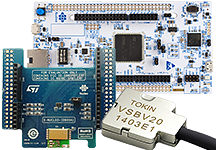
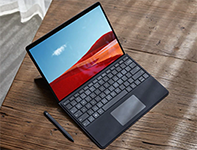

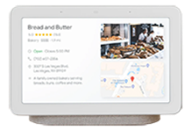
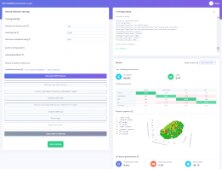
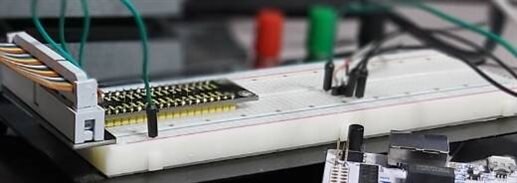
Top Comments